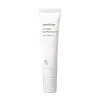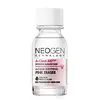What's inside
What's inside
 Key Ingredients
Key Ingredients

 Benefits
Benefits

 Concerns
Concerns

 Ingredients Side-by-side
Ingredients Side-by-side

Water
Skin ConditioningPropanediol
SolventGlycerin
HumectantCyclopentasiloxane
EmollientSqualane
EmollientCyclohexasiloxane
EmollientCetearyl Alcohol
EmollientPanthenol
Skin Conditioning1,2-Hexanediol
Skin ConditioningC12-16 Alcohols
EmollientDiisostearyl Malate
EmollientPolysorbate 60
EmulsifyingHydroxyethyl Acrylate/Sodium Acryloyldimethyl Taurate Copolymer
Emulsion StabilisingAcrylates/C10-30 Alkyl Acrylate Crosspolymer
Emulsion StabilisingTromethamine
BufferingHydrogenated Lecithin
EmulsifyingPalmitic Acid
EmollientCetearyl Glucoside
EmulsifyingTorreya Nucifera Seed Oil
EmollientDisodium EDTA
Madecassoside
AntioxidantAsiaticoside
AntioxidantCamellia Japonica Leaf Extract
Skin ConditioningCamellia Sinensis Leaf Extract
AntimicrobialCitrus Unshiu Peel Extract
MaskingOpuntia Coccinellifera Fruit Extract
Skin ConditioningOrchid Extract
Skin ConditioningMadecassic Acid
Skin ConditioningAsiatic Acid
Skin ConditioningWater, Propanediol, Glycerin, Cyclopentasiloxane, Squalane, Cyclohexasiloxane, Cetearyl Alcohol, Panthenol, 1,2-Hexanediol, C12-16 Alcohols, Diisostearyl Malate, Polysorbate 60, Hydroxyethyl Acrylate/Sodium Acryloyldimethyl Taurate Copolymer, Acrylates/C10-30 Alkyl Acrylate Crosspolymer, Tromethamine, Hydrogenated Lecithin, Palmitic Acid, Cetearyl Glucoside, Torreya Nucifera Seed Oil, Disodium EDTA, Madecassoside, Asiaticoside, Camellia Japonica Leaf Extract, Camellia Sinensis Leaf Extract, Citrus Unshiu Peel Extract, Opuntia Coccinellifera Fruit Extract, Orchid Extract, Madecassic Acid, Asiatic Acid
Water
Skin ConditioningAlcohol Denat.
AntimicrobialCalamine
AbsorbentGlycerin
HumectantMelaleuca Alternifolia Leaf Oil
AntioxidantAsiaticoside
AntioxidantMadecassic Acid
Skin ConditioningAsiatic Acid
Skin ConditioningMadecassoside
AntioxidantCamellia Sinensis Leaf Extract
AntimicrobialOpuntia Coccinellifera Fruit Extract
Skin ConditioningCentella Asiatica Extract
CleansingSapindus Trifoliatus Fruit Extract
Skin ConditioningCamellia Japonica Seed Extract
Skin ConditioningCamellia Japonica Flower Extract
EmollientCitrus Unshiu Peel Extract
MaskingRubus Idaeus Fruit Extract
AstringentCymbopogon Citratus Extract
Skin ConditioningMelissa Officinalis Leaf Extract
Skin ConditioningVaccinium Angustifolium Fruit Extract
Skin ProtectingCitrus Aurantium Dulcis Fruit Extract
MaskingCarica Papaya Fruit Extract
Skin ConditioningCamellia Japonica Leaf Extract
Skin ConditioningGuaiazulene
AntimicrobialPanthenol
Skin ConditioningGlycyrrhiza Glabra Root Extract
BleachingRubus Fruticosus Fruit Extract
AstringentSalicylic Acid
MaskingPEG-60 Hydrogenated Castor Oil
EmulsifyingTrideceth-10
CleansingButylene Glycol
Humectant1,2-Hexanediol
Skin ConditioningEthylhexylglycerin
Skin ConditioningWater, Alcohol Denat., Calamine, Glycerin, Melaleuca Alternifolia Leaf Oil, Asiaticoside, Madecassic Acid, Asiatic Acid, Madecassoside, Camellia Sinensis Leaf Extract, Opuntia Coccinellifera Fruit Extract, Centella Asiatica Extract, Sapindus Trifoliatus Fruit Extract, Camellia Japonica Seed Extract, Camellia Japonica Flower Extract, Citrus Unshiu Peel Extract, Rubus Idaeus Fruit Extract, Cymbopogon Citratus Extract, Melissa Officinalis Leaf Extract, Vaccinium Angustifolium Fruit Extract, Citrus Aurantium Dulcis Fruit Extract, Carica Papaya Fruit Extract, Camellia Japonica Leaf Extract, Guaiazulene, Panthenol, Glycyrrhiza Glabra Root Extract, Rubus Fruticosus Fruit Extract, Salicylic Acid, PEG-60 Hydrogenated Castor Oil, Trideceth-10, Butylene Glycol, 1,2-Hexanediol, Ethylhexylglycerin
Ingredients Explained
These ingredients are found in both products.
Ingredients higher up in an ingredient list are typically present in a larger amount.
1,2-Hexanediol is a synthetic liquid and another multi-functional powerhouse.
It is a:
- Humectant, drawing moisture into the skin
- Emollient, helping to soften skin
- Solvent, dispersing and stabilizing formulas
- Preservative booster, enhancing the antimicrobial activity of other preservatives
Asiatic Acid is a major component of Centella Asiatica Extract. It has wound-healing, anti-inflammatory, and antioxidant properties.
Studies show Asiatic Acid is able to block the pathway for skin inflammation receptors, helping to soothe skin.
As an antioxidant, asiatic acid helps protect our skin against damaging environmental factors.
Learn more about Asiatic AcidAsiaticoside comes from the super popular skin-soothing ingredient, Centella asiatica. It is one of four active compounds found in the extract of Centella Asiatica.
Asiaticoside is an antioxidant and helps with wound healing. It has been shown to increase antioxidant activity during the wound healing process.
Camellia Japonica Leaf Extract comes from the leaves of the Camellia japonica plant. This plant is native to East Asia.
The leaves of Camellia Japonica have been found to have anti-inflammatory compounds. These include squalene, lupeol, and vitamin E.
This extract is created by using 50% 1,3-Butylene glycol.
Learn more about Camellia Japonica Leaf ExtractCamellia Sinensis Leaf Extract is derived from the leaves of the tea plant. Black tea, green tea, and oolong tea are all harvested from this plant.
This ingredient has many skin benefits:
This ingredient contains polyphenols, a strong antioxidant. Antioxidants help fight off molecules that damage skin cells.
On top of that, the antioxidants in green tea neutralize free-radicals from the sun. This gives the skin some extra UV protection, but should not replace sunscreen.
Many components of tea have anti-inflammatory properties.
Polyphenols and L-theanine help soothe the skin and reduce irritation. The caffeine in Camellia Sinensis Leaf Extract helps calm inflamed blood vessels.
Other compounds found in tea include: Vitamin Bs, linoleic acid, magnesium, calcium, iron, and zinc.
Research has shown both drinking Camellia Sinensis Leaf Tea and applying it to the skin can help boost skin elasticity and hydration. Studies also show using tea extract may reduce sebum, or oil, production.
Learn more about Camellia Sinensis Leaf ExtractWe don't have a description for Citrus Unshiu Peel Extract yet.
Glycerin is already naturally found in your skin. It helps moisturize and protect your skin.
A study from 2016 found glycerin to be more effective as a humectant than AHAs and hyaluronic acid.
As a humectant, it helps the skin stay hydrated by pulling moisture to your skin. The low molecular weight of glycerin allows it to pull moisture into the deeper layers of your skin.
Hydrated skin improves your skin barrier; Your skin barrier helps protect against irritants and bacteria.
Glycerin has also been found to have antimicrobial and antiviral properties. Due to these properties, glycerin is often used in wound and burn treatments.
In cosmetics, glycerin is usually derived from plants such as soybean or palm. However, it can also be sourced from animals, such as tallow or animal fat.
This ingredient is organic, colorless, odorless, and non-toxic.
Glycerin is the name for this ingredient in American English. British English uses Glycerol/Glycerine.
Learn more about GlycerinMadecassic Acid is a major component of Centella Asiatica Extract. It has anti-inflammatory and antioxidant properties.
It is a triterpenoid, meaning it naturally acts as an antioxidant. Antioxidants protect your skin against damage from environmental factors such as pollution and UV.
Studies show Madecassic Acid helps soothe the skin due to its ability to block inflammation pathways.
Learn more about Madecassic AcidMadecassoside comes from the super popular skin-soothing ingredient, Centella asiatica. It is one of four active compounds found in the extract of Centella Asiatica.
Madecassoside has antioxidant, anti-inflammatory, and hydrating properties. It contains fatty acids, amino acids, beta-carotene, and phytochemicals.
One study found using Madecassoside with ascorbic acid helped reduce the signs of aging and improved skin hydration.
Learn more about MadecassosideWe don't have a description for Opuntia Coccinellifera Fruit Extract yet.
Panthenol is a common ingredient that helps hydrate and soothe the skin. It is found naturally in our skin and hair.
There are two forms of panthenol: D and L.
D-panthenol is also known as dexpanthenol. Most cosmetics use dexpanthenol or a mixture of D and L-panthenol.
Panthenol is famous due to its ability to go deeper into the skin's layers. Using this ingredient has numerous pros (and no cons):
Like hyaluronic acid, panthenol is a humectant. Humectants are able to bind and hold large amounts of water to keep skin hydrated.
This ingredient works well for wound healing. It works by increasing tissue in the wound and helps close open wounds.
Once oxidized, panthenol converts to pantothenic acid. Panthothenic acid is found in all living cells.
This ingredient is also referred to as pro-vitamin B5.
Learn more about PanthenolWater. It's the most common cosmetic ingredient of all. You'll usually see it at the top of ingredient lists, meaning that it makes up the largest part of the product.
So why is it so popular? Water most often acts as a solvent - this means that it helps dissolve other ingredients into the formulation.
You'll also recognize water as that liquid we all need to stay alive. If you see this, drink a glass of water. Stay hydrated!
Learn more about Water